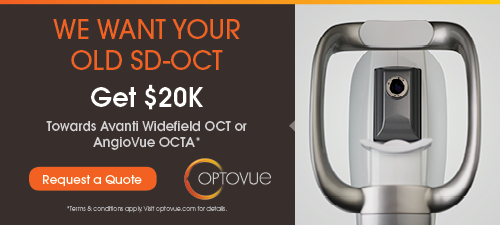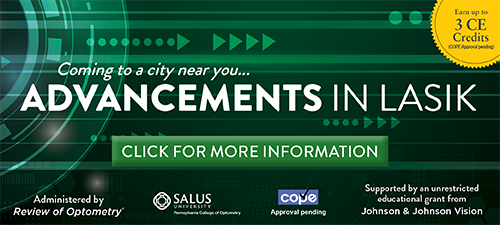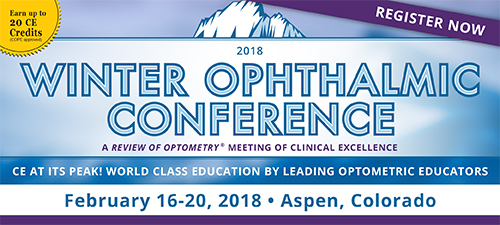
A
weekly e-journal by Art Epstein, OD, FAAO
Off the Cuff: Commonality
There are lessons to be learned from just about everything. Several years ago I received my ratings for several lectures I presented at a major educational conference. I recalled that my talks had gone extremely well and my ratings reflected that—except for one lecture. Oddly, it was the one I thought was my best. Apparently the audience didn’t agree.
|
|||||
|
|||
| Refractive Error & Vision Correction in a General Sports-playing Population | ||||
This study evaluated, in an amateur sports-playing population, the prevalence of refractive error, the type of vision correction used during sport and attitudes toward different kinds of vision correction used in various types of sports. A questionnaire was used for people engaging in sports, and data was collected from sport centers, gyms and universities that focused on the motor sciences.
A total of 1,573 questionnaires were collected (mean age 26.5 ± 12.9 years; 63.5% male). Nearly all (93.8%) subjects stated that their vision had been checked at least once. Fifty-three subjects (3.4%) had undergone refractive surgery. Of the remainder who did not have refractive surgery (n=1,519), 580 (38.2%) reported a defect of vision, 474 (31.2%) were myopic, 63 (4.1%) hyperopic and 241 (15.9%) astigmatic. Logistic regression analysis showed that the best predictors for myopia prevalence were gender (p<0.001) and location of sports practice (p<0.001). Sports with a higher prevalence of outdoor activity had a lower prevalence of myopia. Contact lens penetration over the study sample was 18.7%. Contact lenses were the favorite system of correction among people interviewed compared with spectacles and refractive surgery (p<0.001). This study showed that sports were not associated with different levels of myopia prevalence in the adult population. However, subjects engaging in outdoor sports had lower rates of myopia prevalence. Penetration of contact lens use in sports was four times higher than the overall adult population. Contact lenses were the preferred system of correction in sports compared with spectacles or refractive surgery, but this preference was affected by the type of sport practiced, and by the age and level of sports activity for which the preference was required. |
||||
SOURCE: Zeri F, Pitzalis S, Di Vizio A, et al. Refractive error and vision correction in a general sports-playing population. Clin Exp Optom. 2017; Nov 9. [Epub ahead of print]. |
||||

|
||
Comparison of FDA Safety & Efficacy Data for Corneal Inlays |
||||
This study provided a side-by-side analysis of the summary of safety and effectiveness data (SSED) submitted to the FDA for the Kamra and Raindrop corneal inlays for the correction of presbyopia. SSED reports submitted to the FDA for Kamra and Raindrop were compared with respect to loss of corrected distance visual acuity (CDVA), adverse event rates, induction of astigmatism, retention of contrast sensitivity, stability of manifest refractive spherical equivalent (MRSE) and achieved monocular uncorrected near visual acuity (UNVA) at 24 months.
Totally 442/508 of KAMRA patients and 344/373 Raindrop patients remained enrolled in the clinical trials at 24 months. The proportion of Kamra and Raindrop patients who lost ≥2 lines of CDVA at 24 months was 3.4% and 1%, respectively. The adverse event rate was comparable between the devices. No significant inductions of astigmatism were noted. Both technologies induced a transient myopic shift in MRSE followed by a hyperopic shift and subsequent stabilization. Totally 87% of Kamra and 98% of Raindrop patients attained a monocular UNVA of J5 (20/40) or better at 24 months, 28% of Kamra and 67% of Raindrop patients attained a monocular UNVA of J1 (20/20) or better at 24 months. Researchers concluded that both devices could be considered safe and effective; however, they added that the results of corneal inlay implantation were mixed and that long-term patient satisfaction would likely depend on subjective expectations about the capabilities of the inlays. Variability in surgical technique and postoperative care within and between the two clinical trials diminished the comparative power of this study, researchers added. |
||||
SOURCE: Moshirfar M, Desautels JD, Wallace RT, et al. Comparison of FDA safety and efficacy data for KAMRA and Raindrop corneal inlays. Int J Ophthalmol. 2017;10(9):1446-51. |
||||
 |
||
| Protective Effect of Metformin Against Retinal Vein Occlusions in Diabetes Mellitus: A Nationwide Population-based Study | ||||
Previous studies have found that metformin can reduce cardiovascular risk, but its association with retinal vein occlusion (RVO) is unknown, investigators wrote. In a population-based cohort study using the Taiwan National Health Insurance Research Database (NHIRD), they demonstrated the protective effect of metformin against RVO in diabetes mellitus (DM) and explored the incidence rate and factors associated with RVO development in general and diabetic populations. One million patients were randomly selected from the registry files of the NHIRD, and all their claims data were collected for the 1996-2011 period. Patients with a new diagnosis of central or branch RVO were identified using International Classification of Disease codes. DM was defined for patients with diagnoses and treatments. Factors associated with RVO development in the non-DM and DM cohorts were explored using Cox proportional regression models.
In total, 1,018 RVO patients were identified from the database. The average incidence of RVO was 9.93 and 53.5 cases per 100,000 person-years in the non-DM and DM cohorts, respectively. Older age, DM, hypertension and glaucoma were significant risk factors for RVO, whereas the prescription of anticoagulants was a significant protective factor. In the DM cohort, older age, hypertension and diabetic retinopathy were significant risk factors for RVO, whereas metformin treatment was a significant protective factor. Investigators determined that the results confirmed the risk factors for RVO and demonstrated the protective effect of metformin against RVO in DM patients. They added that prescribing metformin for DM patients might be beneficial for reducing the incidence of RVO, along with its hypoglycemic action. |
||||
SOURCE: Lin TC, Hwang DK, Hsu CC, et al. Protective effect of metformin against retinal vein occlusions in diabetes mellitus - A nationwide population-based study. PLoS One. 2017;12(11):e0188136. |
||||
|
|||
| News & Notes | ||||||||
| Bausch + Lomb: More Than 1 Million Units of CL Materials Recycled Bausch + Lomb’s One by One Recycling Program recycled a combined total of more than one million used contact lenses, blister packs and top foils in less than one year since the launch of the program. The program, in collaboration with TerraCycle has diverted more than 7,000 pounds of waste from landfills and has helped create new post-consumer products. Eye care professionals who are registered with the One by One Recycling Program are provided custom recycling bins for collection in the office. Patients can bring in their contact lens materials from home, and the practice can collect lenses used within the office. The items are sent to TerraCycle for proper recycling using a free shipping label by Bausch + Lomb. In addition to the One by One Program supporting environmental sustainability, for every pound of waste accepted, a $1 donation is made to Optometry Giving Sight. Read more.
|
||||||||
SECO 2018 Launches Customized Educational Content
|
||||||||
| Paragon Hosts Myopia Symposium for Cornea & Contact Lens and Pediatric Optometry Residents Paragon Vision Sciences hosted nearly 30 pediatric and corneal contact lens optometry residents from universities around the country and Canada at a symposium designed to provide residents with clinical expertise about the diagnosis and treatment of myopia. The event, held at the Paragon Education and Training Academy at the company’s headquarters in Gilbert, Ariz., provided a unique educational opportunity for attendees to learn about treatment options and myopia research from leading experts. Residents also received instruction on the use of topography to achieve optimal treatment outcomes, including wet lab sessions with patients being fit in orthokeratology contact lenses. |
||||||||
|
Kala Pharmaceuticals Submits NDA for Inveltys Kala Pharmaceuticals submitted a New Drug Application to the U.S. Food and Drug Administration for Inveltys (KPI-121 1%), a topical, twice-daily corticosteroid for the treatment of inflammation and pain in individuals who have undergone ocular surgery. If approved, Kala expects Inveltys would be the first twice-daily ocular corticosteroid indicated for the treatment of postoperative ocular inflammation and pain. Read more. |
||||||||
|
Optometric Physician™ (OP) newsletter is owned and published by Dr. Arthur Epstein. It is distributed by the Review Group, a Division of Jobson Medical Information LLC (JMI), 11 Campus Boulevard, Newtown Square, PA 19073. HOW TO ADVERTISE |





